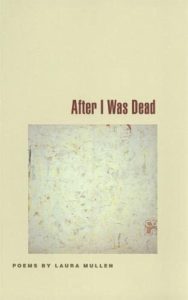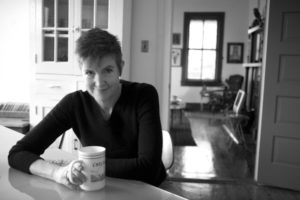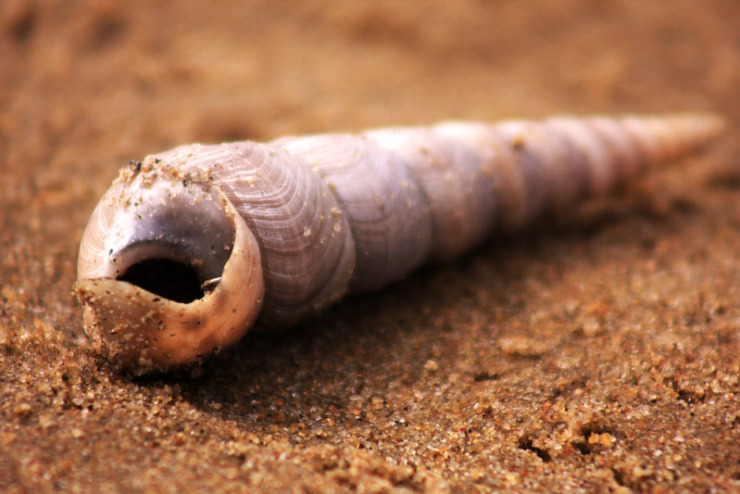Laura Mullen experiments with poetic form — and personal history is reinvented
November, 2022: It’s just over 53 years since I first walked on the campus at Louisiana State University in Baton Rouge as a college freshman. I’m in the school’s bookstore, which is nothing like the one I remember in the Student Union. This one is across the street from the union and operated by Barnes and Noble. And in this day of electronic textbooks, the bookstore more resembles a large department store filled with LSU-brand clothing and merchandise of all shapes, sizes and varieties.
Still, there are physical books, tucked away on the second floor. Right by the escalator are two shelves of books by faculty authors. And it’s there I find After I Was Dead, a poetry collection by Laura Mullen bearing the sticker “faculty author.”
The bookstore hasn’t quite caught up with current events. Mullen is no longer at LSU but is now at Wake Forest University. And this particular collection was originally published in 1999 and reissued in 2008. But as I look through it, I can see that these poems surprisingly speak to the kind of day it’s been for a visit back to my university.
Held in place:
The sense of there being no place for anything other
Than the dutiful return
To the picturesque.
(from “House”)

The core of the campus looks the same — the Quadrangle and the 1920s buildings surrounding it, the Works Progress Administration murals in several of them, the 1960s library sitting at one end and what was the College of Engineering building at the other end. The plaza in front of the library was one of the great gathering places when I was a student, but it’s empty now.
Some campus buildings have disappeared, and new ones rise in their place. The “new” chemistry building, for example, which opened my senior year, has now been demolished and replaced.
How the whole
Structure vanished or became
Something else.
What was that dream we had?
(from “Western Civ.”)
What had been my freshman dorm is now faculty and staff offices. I wonder if the professors flood the hallways and have surfing parties, or for grins throw a two-foot-long alligator into the communal shower. Likely not.
What is rather surprising is how much, even after 50 years, looks the same. The Indian Mounds and the Parade Ground are still there, as is the amphitheater, which was being prepared for a church service. The football stadium has a huge upper deck that wasn’t there in the early 1970s. The Journalism Building, where I had all of my classes and worked as a reporter, copy editor, and managing editor of the school newspaper, looks mostly the same. It’s been remodeled and a small auditorium added; most of the classes are now held in another building. I peek into one room and see a class under way. And I think to myself, do the students know that this was the newspaper office, where countless dramas played out? Do they know that it was in this very room where I met my future wife?
Memory overflowing its salt-rimmed dike?
But your version only, “the” truth…
(from “After I Was Dead”)

Laura Mullen
Mullen has published several poetry collections, including The Surface, The Tales of Horror, Subject, Murmur, Dark Archive, and Enduring Freedom, and her work has been included in several poetry anthologies. Her new collection, EtC, will be published this spring. She teaches in the Summer Writing Program at the Jack Kerouac School of Disembodied Poetics and is the Kenan Chair in the Humanities at Wake Forest University. She previously has taught literature, creative writing, and film at LSU.
It’s the smell of the sweet olive outside Allen Hall that surprises me, and suddenly it’s 1969, I’m taking German 1, five days a week at 7:30 a.m. in a basement classroom in Prescott Hall next door. And five days a week, at 7 p.m., I’m on the second floor in the language lab, headphones on and listening to the repetition of words and phrases, sounding each one, and now all I can remember is spurlos verschwunden, or “disappeared with a trace.”
This is what happens, I say,
Trying to shove it all back
In some kind of order, trying
To remember how everything
Went before—positioned
In reference—looking for some
Epiphany to liberate…
(from “White Paintings II”)
Photo by Vinoth Chandar, Creative Commons, via Flickr. Post by Glynn Young.
How to Read a Poem uses images like the mouse, the hive, the switch (from the Billy Collins poem)—to guide readers into new ways of understanding poems. Anthology included.
“I require all our incoming poetry students—in the MFA I direct—to buy and read this book.”
—Jeanetta Calhoun Mish
- Poets and Poems: Katie Kalisz and “Flu Season” - April 15, 2025
- Poets and Poems: Michelle Ortega and “When You Ask Me, Why Paris?” - April 10, 2025
- Robert Waldron Imagines the Creation of “The Hound of Heaven” - April 8, 2025


Leave a Reply